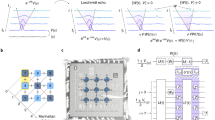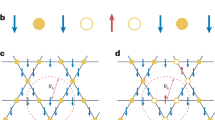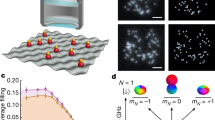Abstract
Dissipation is an unavoidable feature of quantum systems, typically associated with decoherence and the modification of quantum correlations. In the study of strongly correlated quantum matter, we often have to overcome or suppress dissipation to uncover the underlying quantum phenomena. However, here we demonstrate that dissipation can serve as a probe for intrinsic correlations in quantum many-body systems. Applying tunable dissipation in ultracold atomic systems, we observe universal dissipative dynamics in strongly correlated one-dimensional quantum gases. Specifically, we find a universal stretched-exponential decay of the total particle number, where the stretched exponent measures the anomalous dimension of the spectral function—a parameter for characterizing strong quantum fluctuations. This approach offers a versatile framework for probing features of strongly correlated systems, including spin–charge separation and Fermi arcs in quantum materials.
This is a preview of subscription content, access via your institution
Access options
Access Nature and 54 other Nature Portfolio journals
Get Nature+, our best-value online-access subscription
$32.99 / 30 days
cancel any time
Subscribe to this journal
Receive 12 print issues and online access
$259.00 per year
only $21.58 per issue
Buy this article
- Purchase on SpringerLink
- Instant access to full article PDF
Prices may be subject to local taxes which are calculated during checkout




Similar content being viewed by others
Data availability
The data that support the findings of this study are available in the repository https://cloud.tsinghua.edu.cn/d/f5c45e9cb7124155979f/. Any additional information is available from the corresponding authors upon reasonable request.
References
Diehl, S. et al. Quantum states and phases in driven open quantum systems with cold atoms. Nat. Phys. 4, 878–883 (2008).
Breuer, H.-P., Laine, E.-M., Piilo, J. & Vacchini, B. Colloquium: Non-Markovian dynamics in open quantum systems. Rev. Mod. Phys. 88, 021002 (2016).
Ashida, Y., Gong, Z. & Ueda, M. Non-Hermitian physics. Adv. Phys. 69, 249–435 (2020).
Bergholtz, E. J., Budich, J. C. & Kunst, F. K. Exceptional topology of non-Hermitian systems. Rev. Mod. Phys. 93, 015005 (2021).
Bouganne, R., Bosch Aguilera, M., Ghermaoui, A., Beugnon, J. & Gerbier, F. Anomalous decay of coherence in a dissipative many-body system. Nat. Phys. 16, 21–25 (2020).
Léonard, J., Morales, A., Zupancic, P., Esslinger, T. & Donner, T. Supersolid formation in a quantum gas breaking a continuous translational symmetry. Nature 543, 87–90 (2017).
Ma, R. et al. A dissipatively stabilized Mott insulator of photons. Nature 566, 51–57 (2019).
Ferioli, G., Glicenstein, A., Ferrier-Barbut, I. & Browaeys, A. A non-equilibrium superradiant phase transition in free space. Nat. Phys. 19, 1345–1349 (2023).
Dogra, L. H.et al. Universal equation of state for wave turbulence in a quantum gas. Nature 620, 521–524 (2023).
Inouye, S. et al. Superradiant Rayleigh scattering from a Bose–Einstein condensate. Science 285, 571–575 (1999).
Baumann, K., Guerlin, C., Brennecke, F. & Esslinger, T. Dicke quantum phase transition with a superfluid gas in an optical cavity. Nature 464, 1301–1306 (2010).
Zhang, X. et al. Observation of a superradiant quantum phase transition in an intracavity degenerate Fermi gas. Science 373, 1359–1362 (2021).
Konishi, H., Roux, K., Helson, V. & Brantut, J.-P. Universal pair polaritons in a strongly interacting Fermi gas. Nature 596, 509–513 (2021).
Lu, Y.-K., Margalit, Y. & Ketterle, W. Bosonic stimulation of atom–light scattering in an ultracold gas. Nat. Phys. 19, 210–214 (2023).
Keßler, H. et al. Observation of a dissipative time crystal. Phys. Rev. Lett. 127, 043602 (2021).
Kongkhambut, P. et al. Observation of a continuous time crystal. Science 377, 670–673 (2022).
Lin, Y. et al. Dissipative production of a maximally entangled steady state of two quantum bits. Nature 504, 415–418 (2013).
Krauter, H. et al. Entanglement generated by dissipation and steady state entanglement of two macroscopic objects. Phys. Rev. Lett. 107, 080503 (2011).
Pan, L., Chen, X., Chen, Y. & Zhai, H. Non-Hermitian linear response theory. Nat. Phys. 16, 767–771 (2020).
Sachdev, S. Quantum Phase Transitions 2nd edn (Cambridge Univ. Press, 2011).
Giamarchi, T. Quantum Physics in One Dimension (Oxford Univ. Press, 2003).
Jiang, Y.-Z., Chen, Y.-Y. & Guan, X.-W. Understanding many-body physics in one dimension from the Lieb–Liniger model. Chin. Phys. B 24, 050311 (2015).
Liang, L. et al. Probing quantum many-body correlations by universal ramping dynamics. Sci. Bull. 67, 2550–2556 (2022).
Kinoshita, T., Wenger, T. & Weiss, D. S. Observation of a one-dimensional Tonks–Girardeau gas. Science 305, 1125–1128 (2004).
Paredes, B. et al. Tonks–Girardeau gas of ultracold atoms in an optical lattice. Nature 429, 277–281 (2004).
Haller, E. et al. Realization of an excited, strongly correlated quantum gas phase. Science 325, 1224–1227 (2009).
Haller, E. et al. Pinning quantum phase transition for a Luttinger liquid of strongly interacting bosons. Nature 466, 597–600 (2010).
Meinert, F. et al. Bloch oscillations in the absence of a lattice. Science 356, 945–948 (2017).
Yang, B. et al. Quantum criticality and the Tomonaga–Luttinger liquid in one-dimensional Bose gases. Phys. Rev. Lett. 119, 165701 (2017).
Erne, S., Bücker, R., Gasenzer, T., Berges, J. & Schmiedmayer, J. Universal dynamics in an isolated one-dimensional Bose gas far from equilibrium. Nature 563, 225–229 (2018).
Wilson, J. M. et al. Observation of dynamical fermionization. Science 367, 1461–1464 (2020).
Vijayan, J. et al. Time-resolved observation of spin–charge deconfinement in fermionic Hubbard chains. Science 367, 186–189 (2020).
Senaratne, R. et al. Spin–charge separation in a one-dimensional Fermi gas with tunable interactions. Science 376, 1305–1308 (2022).
See Toh, J. H. et al. Many-body dynamical delocalization in a kicked one-dimensional ultracold gas. Nat. Phys. 18, 1297–1301 (2022).
Le, Y., Zhang, Y., Gopalakrishnan, S., Rigol, M. & Weiss, D. S. Observation of hydrodynamization and local prethermalization in 1D Bose gases. Nature 618, 494–499 (2023).
Cavazos-Cavazos, D., Senaratne, R., Kafle, A. & Hulet, R. G. Thermal disruption of a Luttinger liquid. Nat. Commun. 14, 3154 (2023).
Guo, Y. et al. Anomalous cooling of bosons by dimensional reduction. Sci. Adv. 10, 7 (2024).
Yao, H., Pizzino, L. & Giamarchi, T. Strongly-interacting bosons at 2D-1D dimensional crossover. SciPost Phys. 15, 050 (2023).
Kohlert, T. et al. Observation of many-body localization in a one-dimensional system with single-particle mobility edge. Phys. Rev. Lett. 122, 170403 (2019).
Gring, M. et al. Relaxation and prethermalization in an isolated quantum system. Science 337, 1318–1322 (2012).
Dunjko, V., Lorent, V. & Olshanii, M. Thomas–Fermi regime, Tonks–Girardeau regime, and in between. Phys. Rev. Lett. 86, 5413 (2001).
Cheng, S., Chen, Y.-Y., Guan, X.-W., Yang, W.-L. & Lin, H.-Q. One-body dynamical correlation function of Lieb-Liniger model at finite temperature. Phys. Rev. A 111, L010802 (2025).
Cheng, S. et al. Exact spectral function of one-dimensional Bose gases. Preprint at https://arxiv.org/abs/2209.15221 (2022).
Olshanii, M. Atomic scattering in the presence of an external confinement and a gas of impenetrable bosons. Phys. Rev. Lett. 81, 938 (1998).
Palzer, S., Zipkes, C., Sias, C. & Köhl, M. Quantum transport through a Tonks–Girardeau gas. Phys. Rev. Lett. 103, 150601 (2009).
Yao, H., Giamarchi, T. & Sanchez-Palencia, L. Lieb–Liniger bosons in a shallow quasiperiodic potential: Bose glass phase and fractal Mott lobes. Phys. Rev. Lett. 125, 060401 (2020).
Boninsegni, M., Prokof’ev, N. & Svistunov, B. Worm algorithm for continuous-space path integral Monte Carlo simulations. Phys. Rev. Lett. 96, 070601 (2006).
Troyer, M., Ammon, B. & Heeb, E. Parallel object oriented Monte Carlo simulations. Lect. Notes Comput. Sci. 1505, 191 (1998).
Albuquerque, A. et al. The ALPS project release 1.3: open-source software for strongly correlated systems. J. Magn. Magn. Mater. 310, 1187–1193 (2007).
Bauer, B. et al. The ALPS project release 2.0: open source software for strongly correlated systems. J. Stat. Mech. Theory Exp. 2011, P05001 (2011).
Acknowledgements
We acknowledge discussions with H. Zhai, X.-W. Guan and T. Giamarchi and technical support from W. Zhang and Z. Zhang. This work is supported by the National Natural Science Foundation of China (92165203, W.C.; 92476110, J.H.; 12174358, Y.C.), National Key Research and Development Program of China (2022YFA1405300, Y.C.; 2021YFA1400904, W.C.; 2021YFA0718303, J.H.; 2023YFA1406702, W.C.), NSAF (U2330401, Y.C.) and Swiss National Science Foundation (200020-188687, 200020-219400, H.Y.).
Author information
Authors and Affiliations
Contributions
Y.Z., Y.T. and J.Y. built the set-up, performed the experiment and analysed the data with the assistance of Z.Z., Z.C. and T.T. Y.C. and Y.W. built the theoretical model. H.Y. performed the numerical calculations and calibrated the temperature. W.C. and J.H. conceived and supervised this work. Y.Z., Y.T., J.H. and W.C. wrote the manuscript with input from all authors.
Corresponding authors
Ethics declarations
Competing interests
The authors declare no competing interests.
Peer review
Peer review information
Nature Physics thanks Masaya Nakagawa, João Sabino and the other, anonymous, reviewer(s) for their contribution to the peer review of this work.
Additional information
Publisher’s note Springer Nature remains neutral with regard to jurisdictional claims in published maps and institutional affiliations.
Extended data
Extended Data Fig. 1 Dependence of Luttinger parameter on temperature.
The Luttinger parameter K versus the rescaled temperature T/Td, with Td = ℏ2n2/2mkB denoting the degenerate temperature. Different colors represent different dimensionless interaction strengths γ.
Extended Data Fig. 2 Finite-time correction.
a, The cyan line is the dissipation curve in the form of Eq. 5 with η = 0.91. The yellow line is the dissipation curve with the same η = 0.91 but at zero temperature formed in Eq. 4. Here, t* is the rescaled dissipation time t* = πkBTt/h. When we use the stretched-exponential function \(N(0)\exp \left[-{(t/{\tau }_{0}^{{\prime} })}^{{\alpha }^{* }}\right]\) to fit the cyan line, the red line gives α* = 0.69 when we set the time upper bound at t* = 4.8. Here the y axis is in a logarithmic scale and the x axis is in a linear scale. b, For different γ or η, as the t* increases, the fitted α* decreases and the dashed line represents the t* we use in our experiment.
Supplementary information
Supplementary Information
Supplementary Discussion.
Rights and permissions
Springer Nature or its licensor (e.g. a society or other partner) holds exclusive rights to this article under a publishing agreement with the author(s) or other rightsholder(s); author self-archiving of the accepted manuscript version of this article is solely governed by the terms of such publishing agreement and applicable law.
About this article
Cite this article
Zhao, Y., Tian, Y., Ye, J. et al. Universal dissipative dynamics in strongly correlated quantum gases. Nat. Phys. 21, 530–535 (2025). https://doi.org/10.1038/s41567-025-02800-4
Received:
Accepted:
Published:
Issue date:
DOI: https://doi.org/10.1038/s41567-025-02800-4
This article is cited by
-
Resourceful dissipation
Nature Physics (2025)



